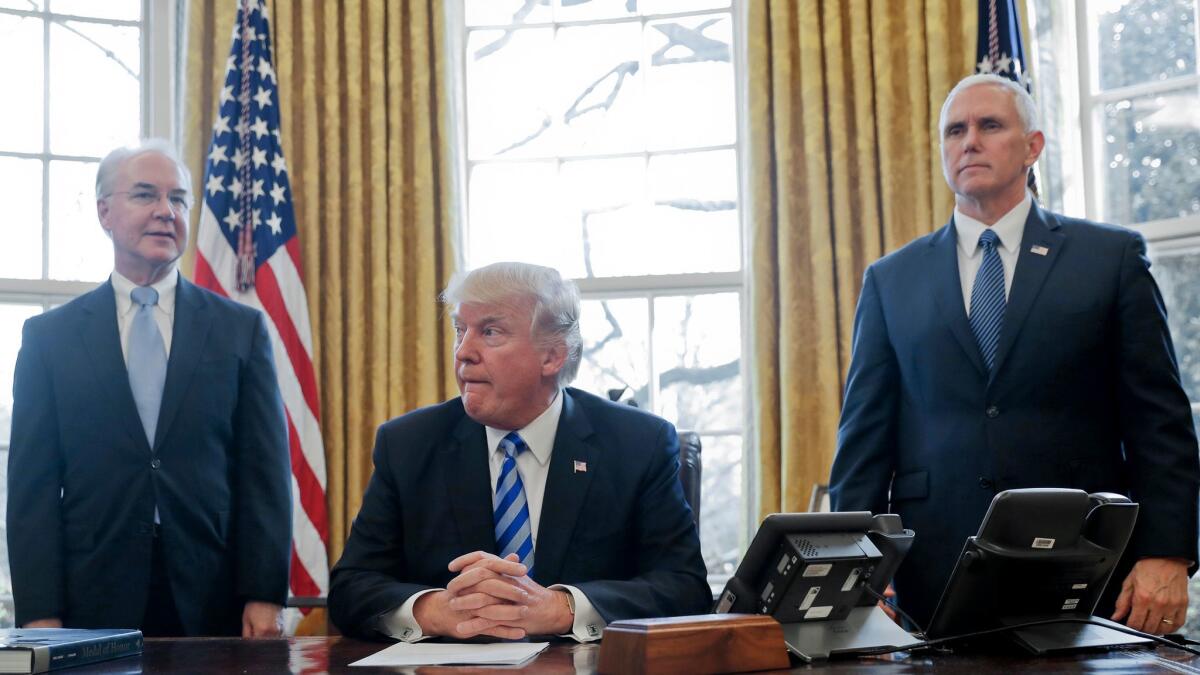Editorial: It’s back to the future for Trumpcare

- Share via
When Congress and the Obama administration sought to reform the healthcare system in 2009, they focused on insuring more people, lowering the cost of care and raising the quality.
The Trump administration appears to be aiming at a different target: reducing the cost of insurance for healthy people. That may sound like a fine goal, but the administration is going about it the wrong way — by returning us to the bad old days when sick people had to pay exorbitant premiums, if they could get coverage at all.
That’s the upshot of the proposal the administration put in front of recalcitrant House conservatives last week after they blocked the GOP leadership’s proposal to “repeal and replace” Obamacare, arguing that it didn’t remove enough of the law’s insurance regulations. Those regulations, members of the arch-conservative Freedom Caucus complained, force healthy people to pick up too much of the costs imposed by the ill and the injured.
They’re not inventing the complaint out of whole cloth. Obamacare (also known as the Affordable Care Act) sought to insure millions of uninsured Americans by providing the same protections in the non-group market that Congress extended to employer plans in 1996: Insurers couldn’t deny any applicants, nor could they charge higher premiums for those with pre-existing conditions. The ACA also required all new insurance policies to cover 10 “essential health benefits,” such as hospitalization and maternity care, that were commonly covered in employer plans.
When insurers sell exemption-laden policies they shifted the risk of hefty medical bills onto their customers.
Those changes aimed to spread the risk and cost of insurance broadly across each state. But for a number of reasons, insurers in some regions racked up big losses, leading to large premium increases. Although the vast majority of the people shopping at state insurance exchanges received subsidies that dulled or eliminated the pain of the premium increases, millions of others who bought individual policies in and out of the exchanges did not. Those are the people hit hardest by the premium increase, especially in states that took a hands-off approach to insurers’ rates and policy offerings.
There are plenty of things Congress and the states could do to try help those consumers, including offering more tax breaks, creating reinsurance funds to mitigate insurers’ risks and working harder to persuade younger, healthier people to buy insurance. What the House GOP leadership proposed, however, was to let insurers sell plans that covered a smaller fraction of their customers’ medical bills — in other words, shift more costs onto those who need care. According to the Congressional Budget Office, that would cause premiums to go up more than the current approach for the first few years, although the increases would eventually be lower by comparison.
After the Freedom Caucus balked, Vice President Mike Pence tried to bring its members back on board last week by proposing to let states waive the ACA provisions barring insurers from denying coverage or charging higher premiums based on pre-existing conditions, as well as the one requiring policies to cover the 10 essential health benefits. In any state that did waive those rules, insurers would likely offer lower-cost policies designed to attract the sort of people insurers like to cover: the ones who don’t need care. Residents there would face the same obstacles they did in the days prior to the ACA, when insurers sold exemption-laden policies that shifted the risk of hefty medical bills onto their customers. They’d also be free to deny coverage to people with expensive chronic conditions or risky lines of work.
Supporters of this approach argue that states could institute “high-risk pools” to cover anyone shunned by private insurers. That’s not a new idea, though — many states (California included) had high-risk pools before the ACA, and the pools proved so costly that states ended up denying coverage to some applicants and for some conditions. In other words, the pools provided little help to the people who needed it most.
Pence’s talks with the Freedom Caucus didn’t bear fruit, so Congress broke for spring recess with the matter still up in the air. While lawmakers are back in their districts, Americans with pre-existing conditions who couldn’t get insurance before the ACA, or who couldn’t get the kind of coverage they needed, need to tell their representatives not to sacrifice their coverage to “solve” the problem of high premiums.
Twitter: @jcahealey
More to Read
A cure for the common opinion
Get thought-provoking perspectives with our weekly newsletter.
You may occasionally receive promotional content from the Los Angeles Times.










